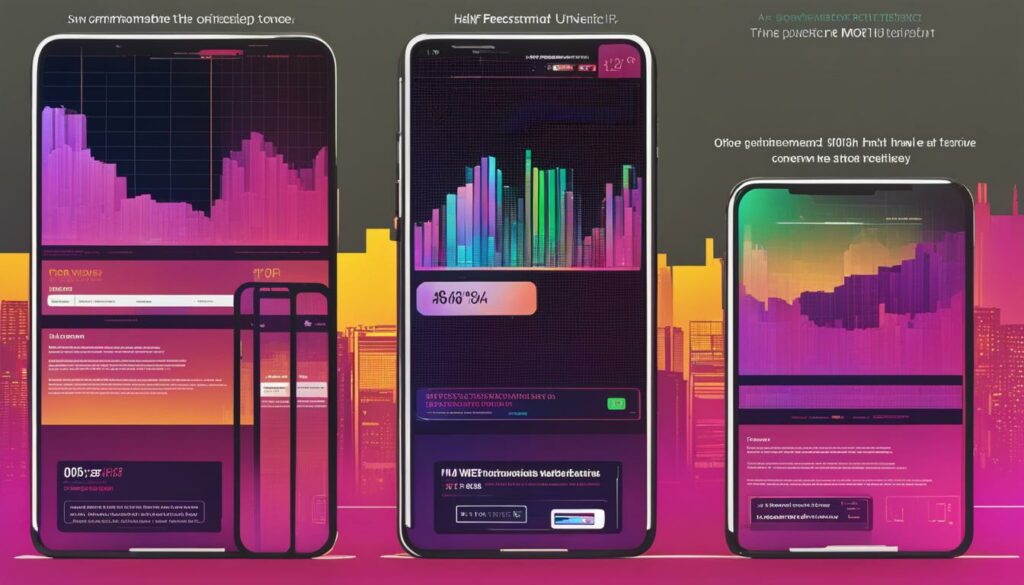Welcome to the era of mobile devices, where smartphones and tablets have revolutionized the way we access the internet. In this digital landscape, having a mobile-friendly website has become more important than ever before. Whether you are a small business or a large corporation, mobile optimization is crucial for the success of your website. By ensuring that your website is optimized for mobile devices, you can provide a seamless user experience, improve search engine rankings, and increase conversion rates.
When it comes to hosting your website, mobile optimization should be a top priority. Your website needs to be responsive and adaptable to different screen sizes and resolutions. This ensures that your content is displayed correctly, regardless of the device your visitors are using. By investing in mobile-friendly website hosting, you can attract and retain more mobile users, who now comprise the majority of internet traffic.
With mobile optimization in hosting, you can optimize your website for mobile devices, ensuring that it loads quickly, is easy to navigate, and provides a seamless user experience. By doing so, you can cater to the preferences and behaviors of your mobile audience, keeping them engaged and satisfied.
Key Takeaways:
- A mobile-friendly website is crucial in today’s mobile-driven world
- Mobile optimization enhances user experience and keeps visitors engaged
- Mobile-friendly website hosting is essential for attracting mobile users
- Optimizing your website for mobile devices improves search engine rankings
- Mobile optimization increases conversion rates and drives business success
The Impact of Mobile Optimization on User Experience
Mobile optimization is crucial for enhancing user experience on websites. A mobile-friendly website is easier to navigate and read on a smaller screen, leading to better engagement, increased time on site, and higher chances of returning visitors.
When a website is optimized for mobile devices, it ensures that users can access and consume content seamlessly, regardless of the device they are using. This accessibility translates into a positive user experience, resulting in higher satisfaction and increased trust in the brand.
One of the key aspects of a positive user experience is website performance on mobile devices. Mobile optimization improves website loading speed, reducing frustration and providing a seamless browsing experience for users. Slow-loading websites can lead to high bounce rates, as users are likely to abandon a website that takes too long to load.
A study conducted by Google found that 53% of mobile site visitors leave a page that takes longer than three seconds to load. In contrast, improving mobile website speed can lead to higher conversion rates. For example, Walmart experienced a 2% increase in conversion rates for every one-second improvement in mobile website speed.
Why is mobile website speed important?
Mobile users expect fast and responsive websites. According to Google, 53% of mobile users abandon sites that take longer than three seconds to load. This means that optimizing your website for speed is crucial for retaining users and preventing them from turning to your competitors.
Here are some key benefits of having a fast-loading mobile website:
- Better user experience: Faster loading speeds result in a better user experience, keeping visitors engaged and increasing the chances of conversion.
- Improved search engine rankings: Website speed is a ranking factor in search engine algorithms, meaning faster websites have a better chance of appearing higher in search results.
- Reduced bounce rate: A slow-loading website increases the likelihood of visitors leaving before exploring further. By optimizing your mobile website speed, you can reduce bounce rates and increase user engagement.
Mobile optimization is not just about making your website look good on mobile devices; it’s about creating a seamless and enjoyable experience for users. By prioritizing mobile optimization and improving website performance and speed, you can ensure that your users have a positive experience, leading to increased engagement and higher conversion rates.
Optimizing your mobile website is not only beneficial for your users but also for your business. Research shows that 88% of consumers who have a negative experience on a mobile website are less likely to make a purchase from that brand.
To illustrate the impact of mobile optimization on user experience, here are some statistics:
| Statistic | Impact |
|---|---|
| 61% of users are unlikely to return to a mobile site they had trouble accessing | A negative user experience can result in lost potential customers |
| 85% of adults believe that a company’s website should be as good or better on mobile than desktop | A mobile-friendly website is an expectation in today’s digital landscape |
| 79% of users who are dissatisfied with a site’s mobile performance are less likely to make a purchase from that site | Mobile optimization directly impacts conversion rates and revenue |
By focusing on mobile optimization and providing a positive user experience, you can position your website for success and gain a competitive advantage in the mobile-first era.
The Importance of Mobile Optimization for SEO
When it comes to search engine optimization (SEO), mobile optimization should be a top priority. With the rise of mobile devices and the increasing number of users accessing the internet on smartphones and tablets, Google has introduced mobile-first indexing, making mobile SEO optimization essential for website success.
Google rewards mobile-friendly websites with higher search engine rankings, prioritizing them in search results. By optimizing your website for mobile devices, you can improve your chances of being found by users who are searching on their phones or tablets.
One of the key benefits of mobile optimization for SEO is improved loading speed. Mobile users expect fast and seamless browsing experiences, and when a website takes too long to load, they are more likely to bounce back and choose a competitor’s site. By optimizing your website for mobile devices and reducing loading times, you can decrease bounce rates and increase user engagement, ultimately leading to better search engine rankings.
Another aspect to consider is the user experience. Mobile-friendly websites are designed to adapt to different screen sizes and resolutions, providing a smooth and intuitive browsing experience. When users can easily navigate and consume content on their mobile devices, they are more likely to stay on your website longer, increasing session duration and improving search engine rankings.
Implementing mobile SEO optimization strategies can be a game-changer for your website’s visibility and success. By prioritizing mobile optimization and ensuring that your website is mobile-friendly, you can attract more organic traffic, increase user engagement, and ultimately drive better results for your business.
Key Benefits of Mobile Optimization for SEO:
- Higher search engine rankings
- Improved loading speed
- Reduced bounce rate
- Enhanced user experience
- Increased organic traffic
Mobile Optimization Best Practices:
- Utilize responsive web design to ensure your website adapts to different screen sizes.
- Optimize images for faster loading on mobile devices.
- Minimize the use of pop-ups and interstitials, which can hinder the user experience on mobile devices.
- Use clear and concise headings to improve readability on smaller screens.
- Simplify navigation for easy browsing on mobile devices.
- Optimize calls-to-action (CTAs) to drive conversions from mobile users.
- Regularly test your website on various mobile devices to ensure optimal performance.
By following these best practices and staying up-to-date with the latest mobile optimization techniques, you can maximize your website’s visibility, improve user experience, and achieve better search engine rankings.
| Mobile Optimization | SEO Benefits |
|---|---|
| Higher search engine rankings | Improved visibility and organic traffic |
| Reduced bounce rate | Increased user engagement |
| Improved loading speed | Enhanced user experience |

The Impact of Mobile Optimization on Conversion Rates
When it comes to optimizing websites for mobile users, the impact on conversion rates cannot be underestimated. A mobile-optimized website provides a seamless experience for users, making it easier for them to take action, whether it’s making a purchase or filling out a form.
One of the key factors in improving conversion rates through mobile optimization is simplifying navigation. Mobile users have limited screen space, and they need to find what they’re looking for quickly and effortlessly. By implementing clear, intuitive navigation menus and ensuring easy access to important sections of your website, you can guide users towards the desired conversion actions.
Clear calls-to-action (CTAs) are another crucial element for boosting conversion rates on mobile devices. With limited screen real estate, it’s important to make your CTAs stand out. Use contrasting colors, persuasive copy, and strategic placement to draw attention and motivate users to take the desired action.
“A mobile-optimized website provides a seamless experience for users, making it easier for them to take action, such as making a purchase or filling out a form.”
Optimizing forms for mobile devices is also essential for improving conversion rates. Mobile users have to deal with smaller screens and touch inputs, which can make form filling cumbersome. By streamlining your forms, minimizing the number of required fields, and using autofill features, you can simplify the process and encourage more users to complete the conversion.

Case Study: How Mobile Optimization Boosted Conversion Rates for XYZ Company
| Before Mobile Optimization | After Mobile Optimization |
|---|---|
| Conversion Rate: 2% | Conversion Rate: 5% |
| Bounce Rate: 60% | Bounce Rate: 35% |
| Average Session Duration: 1:30 | Average Session Duration: 3:00 |
In a case study conducted by XYZ Company, implementing mobile optimization strategies resulted in a significant improvement in conversion rates. Before the mobile optimization effort, the conversion rate was only 2%. However, after making the necessary adjustments to ensure a seamless mobile experience, the conversion rate skyrocketed to 5%.
Additionally, the bounce rate decreased from 60% to 35%, indicating that users were more engaged with the website and found what they were looking for more easily. The average session duration also increased from 1 minute and 30 seconds to 3 minutes, demonstrating that users were spending more time exploring the website and considering their actions.
This case study clearly highlights the positive impact that mobile optimization can have on conversion rates. By prioritizing the mobile user experience and optimizing your website accordingly, you can drive more conversions and ultimately achieve greater success for your business.
Best Practices for Mobile Optimization
When it comes to mobile optimization, following best practices can make a significant difference in improving user experience and ensuring the success of your website. Implementing these practices will help you create a mobile-friendly and user-friendly website that performs well on mobile devices. Let’s explore the top best practices:
1. Responsive Web Design
An essential aspect of mobile optimization is using responsive web design. This approach allows your website to adapt and adjust its layout automatically based on the screen size of the device being used. By using responsive design, your website will look great and provide an optimal experience across various devices, including smartphones and tablets.
2. Mobile-Friendly Fonts
Choosing the right fonts for your mobile website is crucial for readability and user experience. Opt for fonts that are easy to read on small screens and ensure they scale properly on different resolutions. Avoid using complex or decorative fonts that may hinder readability on mobile devices.
3. Optimizing Images for Mobile Devices
Images play a significant role in enhancing the overall visual appeal of your website. However, large images can slow down loading times on mobile devices. Optimize your images by compressing them, reducing their size, and choosing the appropriate image format for mobile devices. This optimization will help improve loading speed and provide a smoother experience for mobile users.
4. Utilizing Accelerated Mobile Pages (AMP)
Accelerated Mobile Pages (AMP) is an open-source initiative that enhances the performance and speed of mobile web pages. By implementing AMP, your website can load faster on mobile devices, reducing bounce rates and improving user engagement. This technology is particularly beneficial for content-focused websites, such as blogs and news platforms.
5. Minimizing Pop-ups and Interstitials
Pop-ups and interstitials, while useful for certain purposes, can be intrusive and disrupt the user experience on mobile devices. Minimize their usage or consider alternative methods that do not obstruct content or impede navigation. This will create a seamless browsing experience and prevent users from abandoning your website due to intrusive elements.
6. Clear and Concise Headings
Using clear and concise headings helps users navigate your website easily. Consider the limited screen space on mobile devices and create headings that are informative, concise, and make the content structure clear. This improves readability and allows users to quickly scan and find the information they are seeking.
7. Optimizing Calls-to-Action (CTAs)
Calls-to-action are crucial in guiding users and encouraging them to take desired actions on your website. Optimizing CTAs for mobile devices involves making them prominent, easily clickable, and visible without the need for excessive scrolling. Ensure that your CTAs are designed with mobile users in mind to maximize conversions.
8. Simplifying Navigation
User-friendly navigation is vital for a positive mobile web experience. Simplify your website’s navigation by using a clear and intuitive menu structure. Limit the number of menu items and organize them logically, making it easy for users to access different sections of your website. Include search functionality to assist users in finding specific content quickly.
9. Testing Website on Mobile Devices
Regularly testing your website on various mobile devices is essential to ensure optimal performance and usability. Test how your website appears and functions across different screen sizes, browsers, and operating systems. This testing will help you identify and fix any issues or inconsistencies that may arise on mobile devices.
By following these best practices, you can create a mobile-optimized website that provides an exceptional user experience on any device. Prioritizing mobile optimization will help you attract more visitors, keep them engaged, and boost your website’s search engine rankings.
| Best Practices | Benefits |
|---|---|
| Responsive Web Design | Adapts to different screen sizes for a consistent user experience |
| Mobile-Friendly Fonts | Improves readability and visual appeal on mobile devices |
| Optimizing Images for Mobile Devices | Enhances loading speed and reduces data usage |
| Utilizing Accelerated Mobile Pages (AMP) | Improves page load times and user engagement |
| Minimizing Pop-ups and Interstitials | Prevents interruption and provides a smoother browsing experience |
| Clear and Concise Headings | Aids in content navigation and improves readability |
| Optimizing Calls-to-Action (CTAs) | Increase conversions and user engagement |
| Simplifying Navigation | Enhances user experience and ease of browsing |
| Testing Website on Mobile Devices | Identifies and resolves any mobile-specific issues |
Additional Considerations for Mobile Optimization
While implementing best practices for mobile optimization is crucial, there are additional factors to consider that can further enhance the performance and user experience of your mobile website. Accessibility and website security play key roles in optimizing your site for mobile devices.
Ensuring Accessibility in Mobile Optimization
Accessibility in mobile optimization ensures that all users, including those with disabilities, can easily access and navigate your website. By making your site accessible, you create an inclusive digital experience for everyone. Here are a few tips to improve accessibility:
- Use an appropriate color scheme with sufficient contrast for visually impaired users.
- Provide alternative text descriptions for images, enabling screen readers to interpret them.
- Include closed captions or transcripts for videos to support users with hearing impairments.
- Ensure that the website structure is logical, making it easier for screen reader users to navigate.
By implementing these accessibility features, you can widen your website’s reach and ensure that all users can benefit from your content.
Ensuring Website Security for Mobile Devices
With the increasing usage of mobile devices, it’s crucial to prioritize website security for mobile users. Protecting user data and maintaining trust is vital. Consider the following security measures:
- Use HTTPS protocol to encrypt data transmitted between the user’s device and your website.
- Implement SSL certificates to establish a secure connection and protect sensitive information.
- Regularly update your website’s software and plugins to address security vulnerabilities.
- Monitor your site for any suspicious activities and employ measures to prevent unauthorized access.
By prioritizing website security for mobile devices, you can instill confidence in your users and safeguard their data.

By considering accessibility and website security in your mobile optimization strategy, you can create a seamless and secure experience for all users. These additional considerations contribute to a user-friendly and trustworthy mobile website.
Conclusion
Mobile optimization is an essential aspect of modern web hosting and a crucial factor for the success of any business in today’s digital landscape. With the majority of internet traffic coming from mobile devices, having a mobile-friendly website is no longer optional – it is a necessity.
By optimizing your website for mobile devices, you can not only improve user experience but also boost your search engine rankings. A mobile-friendly website makes it easier for users to navigate, read, and engage with your content, leading to increased time on site, higher chances of returning visitors, and ultimately, better conversion rates.
Mobile optimization provides numerous benefits, including a competitive advantage over competitors who have not yet optimized their websites for mobile devices. By following best practices, such as implementing responsive web design, optimizing images, and using clear calls-to-action, you can create a mobile-optimized website that delivers a seamless user experience and drives success.
Don’t overlook the importance of considering additional factors like accessibility and website security for mobile devices. Ensuring that your website is accessible to all users and protected against potential security threats is vital for providing a positive mobile experience that builds trust and credibility with your audience.
FAQ
Q: Why is mobile optimization important for web hosting?
A: Mobile optimization is crucial for web hosting as it ensures that websites are optimized for mobile devices, providing a seamless user experience and improving engagement. It also helps in boosting search engine rankings and increasing conversion rates.
Q: How does mobile optimization impact user experience?
A: Mobile optimization enhances user experience by making websites easier to navigate and read on smaller screens. It improves website loading speed, leading to better engagement, increased time on site, and higher chances of returning visitors.
Q: What is the significance of mobile optimization for SEO?
A: Mobile optimization plays a vital role in SEO as Google rewards mobile-friendly websites with higher search engine rankings. Optimizing websites for mobile devices improves loading speed, reduces bounce rate, and makes it easier for users to find your website.
Q: How does mobile optimization impact conversion rates?
A: Mobile optimization significantly affects conversion rates by providing a seamless user experience. It simplifies navigation, uses clear calls-to-action, and optimizes forms, making it easier for users to take action, such as making a purchase or filling out a form.
Q: What are the best practices for mobile optimization?
A: Best practices for mobile optimization include implementing responsive web design, using mobile-friendly fonts, optimizing images for faster loading, utilizing Accelerated Mobile Pages (AMP), minimizing pop-ups and interstitials, using clear and concise headings, optimizing calls-to-action (CTAs), simplifying website navigation, and regularly testing the website on mobile devices.
Q: Are there any additional considerations for mobile optimization?
A: Yes, it is important to consider accessibility in mobile optimization to ensure that all users, including those with disabilities, can access and navigate the website. Additionally, website security is crucial for mobile devices, with the use of HTTPS and SSL certificates to protect user data.
Q: Why is mobile optimization important for website success?
A: Mobile optimization is crucial for website success as it improves user experience, boosts search engine rankings, increases conversion rates, and provides a competitive advantage. With the majority of internet traffic coming from mobile devices, having a mobile-friendly website is essential in today’s digital landscape.











